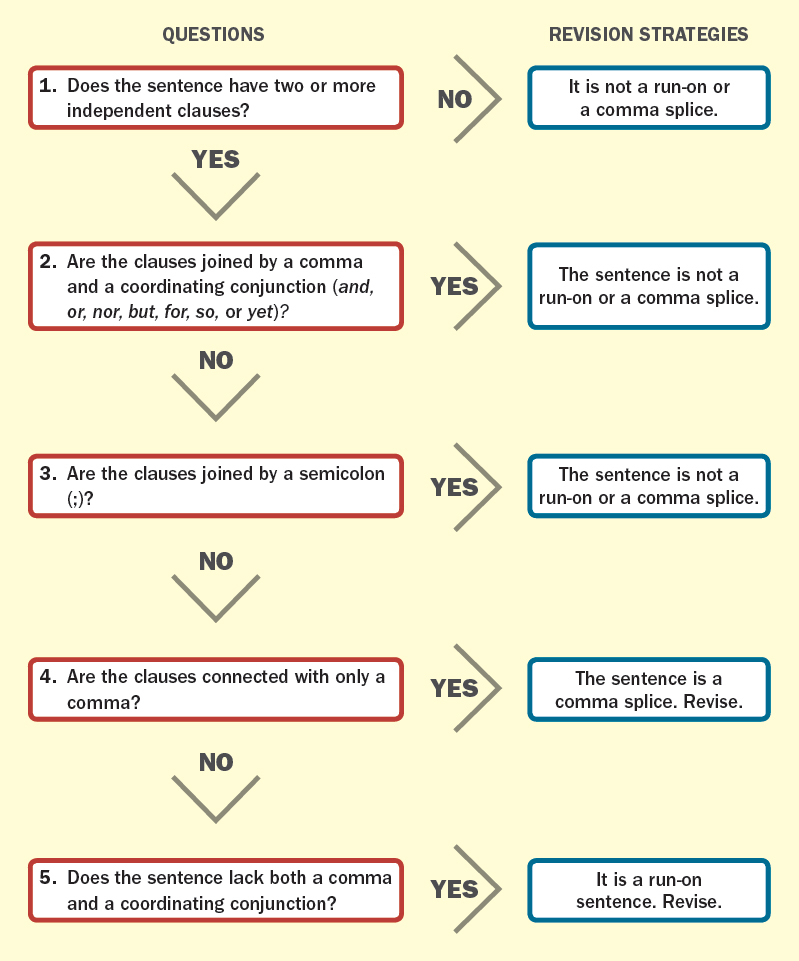4 Run-on Sentences and Comma Splices
4
Run-on Sentences and Comma Splices
A run-on sentence occurs when two or more independent clauses are joined without a punctuation mark or a coordinating conjunction. Run-on sentences are also known as fused sentences.
RUN-ON SENTENCE |
 |
A comma splice occurs when two or more independent clauses are joined with a comma but without a coordinating conjunction (such as and, or, or but).
COMMA SPLICE |
 |
Notice that only a comma separates the two independent clauses, causing the comma splice. |
Another type of comma splice occurs when a word other than a coordinating conjunction is used with a comma to join two or more independent clauses.
COMMA SPLICE |
 |
In the preceding sentence, however is a conjunctive adverb, not a coordinating conjunction. There are only seven coordinating conjunctions: and, but, for, nor, or, so, and yet.
 macmillanhighered.com/successfulwriting LearningCurve > Run-Ons and Comma Splices
macmillanhighered.com/successfulwriting LearningCurve > Run-Ons and Comma Splices
Recognizing Run-on Sentences and Comma Splices
Many students have difficulty spotting run-on sentences and comma splices in their own writing. Use the accompanying flowchart to help you identify these types of errors in your sentences.

Correcting Run-on Sentences and Comma Splices
There are four basic ways to correct a run-on sentence or comma splice. Choose the method that best fits your sentence or intended meaning.
4a Revise by creating two separate sentences
Correct a run-on sentence or comma splice by creating two separate sentences. Make sure each independent clause has the appropriate end punctuation mark — a period, a question mark, or (on rare occasions) an exclamation mark.

RUN-ON SENTENCE |
 |
COMMA SPLICE |
 |
4b Revise by joining the clauses with a semicolon (;)
When the independent clauses are closely connected in meaning, consider joining them with a semicolon. Note that a coordinating conjunction (such as and, or, or but) is not included when you revise with a semicolon (see 4c).

RUN-ON SENTENCE |
 |
COMMA SPLICE |
 |
In the second example, the semicolon joins the two clauses connected by the conjunctive adverb as a result. When two independent clauses are joined by a conjunctive adverb, a semicolon is needed.
4c Revise by joining the clauses with a comma and a coordinating conjunction
Two independent clauses can be joined by using both a comma and a coordinating conjunction (and, but, for, nor, or, so, or yet). The coordinating conjunction indicates how the two clauses are related.

RUN-ON SENTENCE |
 |
COMMA SPLICE |
 |
4d Revise by making one clause dependent or by turning one clause into a phrase
A dependent clause contains a subject and a verb but does not express a complete thought. It must always be linked to an independent clause. You can correct a run-on sentence or a comma splice by adding a subordinating conjunction (such as because or although) to one of the independent clauses, thereby making it a dependent clause. The subordinating conjunction makes the thought incomplete and dependent on the independent clause.

or

RUN-ON SENTENCE |
Facial expressions are very revealing they are an important communication tool. |
INDEPENDENT CLAUSE |
Facial expressions are very revealing. |
DEPENDENT CLAUSE |
Because facial expressions are very revealing |
JOINED TO INDEPENDENT CLAUSE |
Because facial expressions are very revealing, they are an important communication tool. |
You can also correct a run-on sentence or a comma splice by changing one of the independent clauses to a phrase.

or

or

COMMA SPLICE |
Medieval peasants in Europe ate a simple, hearty diet, they relied almost totally on agriculture. |
INDEPENDENT CLAUSE |
Medieval peasants in Europe ate a simple, hearty diet. |
CLAUSE REDUCED TO PHRASE |
having a simple, hearty diet |
EMBEDDED IN INDEPENDENT CLAUSE |
Medieval peasants in Europe—having a simple, hearty diet— relied almost totally on agriculture. |
Note: A comma or commas may or may not be needed to separate a phrase from the rest of the sentence, depending on how the phrase affects the meaning of the sentence (see 12e). Here are two more examples that show how to revise run-on sentences and comma splices using subordination.
RUN-ON SENTENCE |
 |
COMMA SPLICE |
 |